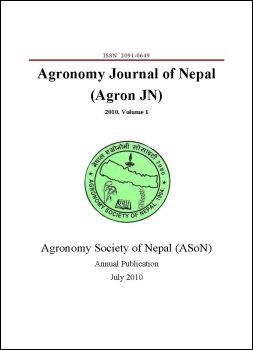Sustainability of productivity in rice-mustard sequential cropping system through integrated nutrient management for terai condition of Nepal
DOI:
https://doi.org/10.3126/ajn.v1i0.7551Keywords:
Sustainability, rice-mustard, sequential cropping, integrated nutrient managementAbstract
In absence of suitable cropping systems in terai, seed yield of mustard is decreasing. Farmers are growing mustard crop under energy starved condition and these are main reasons for low productivity of mustard. With a view to address these issues, an experiment on sustainability of productivity in rice-mustard sequential cropping system through integrated nutrient management for terai condition of Nepal was carried at Nawalpur, Sarlahi during 2004 – 2006. The result revealed that rice grown with 100% recommended dose of fertilizer and 10 tons compost /ha produced a maximum mean grain yield of 4371 kg/ha and straw yield of 5045.5 kg/ha which might be due to maximum dry matter accumulation. Likewise, it was exhibited that application of recommended dose of fertilizer with 10 t compost on preceding rice resulted in maximum seed yield of mustard (1259 kg/ha). The finding also showed that mustard grown with recommended dose of fertilizer produced a maximum mean seed yield of 1384 kg/ha. There was a positive effect of these treatments on seed yield attributes and seed yield of succeeding mustard. Economic analysis for the effects of treatments resulted a maximum benefit cost (BC) ratio of 2.0 which was obtained for mustard when grown after recommended dose of fertilizer. An encouraging BC ratio of 3.45 was found when mustard was taken with 100% recommended dose of fertilize (RDF).
DOI: http://dx.doi.org/10.3126/ajn.v1i0.7551
Agronomy Journal of Nepal (Agron JN) Vol. 1: 2010 pp.113-122
Downloads
Downloads
Published
How to Cite
Issue
Section
License
ASON permits for free use, distribution and reproduction in any medium if the original work is properly cited and not used for commercial purposes.




